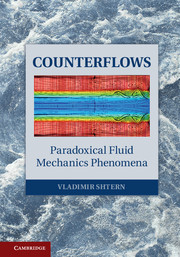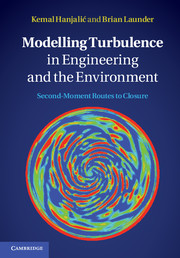Refine search
Actions for selected content:
5487 results in Thermal-fluids engineering
Preface
-
- Book:
- Advanced Aircraft Flight Performance
- Published online:
- 05 January 2013
- Print publication:
- 17 December 2012, pp xxi-xxii
-
- Chapter
- Export citation
Nomenclature
-
- Book:
- Advanced Aircraft Flight Performance
- Published online:
- 05 January 2013
- Print publication:
- 17 December 2012, pp xxiii-xxvi
-
- Chapter
- Export citation
Contents
-
- Book:
- Advanced Aircraft Flight Performance
- Published online:
- 05 January 2013
- Print publication:
- 17 December 2012, pp vii-xvi
-
- Chapter
- Export citation

Counterflows
- Paradoxical Fluid Mechanics Phenomena
-
- Published online:
- 05 November 2012
- Print publication:
- 15 October 2012

Modelling Turbulence in Engineering and the Environment
- Second-Moment Routes to Closure
-
- Published online:
- 05 November 2012
- Print publication:
- 20 October 2011
Acknowledgments
-
- Book:
- Counterflows
- Published online:
- 05 November 2012
- Print publication:
- 15 October 2012, pp xiii-xiv
-
- Chapter
- Export citation
9 - Temperature Distribution in Swirling Counterflows
-
- Book:
- Counterflows
- Published online:
- 05 November 2012
- Print publication:
- 15 October 2012, pp 266-287
-
- Chapter
- Export citation
12 - Control of Vortex Breakdown
-
- Book:
- Counterflows
- Published online:
- 05 November 2012
- Print publication:
- 15 October 2012, pp 342-378
-
- Chapter
- Export citation
10 - Onset of Buoyancy Similarity Counterflows
-
- Book:
- Counterflows
- Published online:
- 05 November 2012
- Print publication:
- 15 October 2012, pp 288-315
-
- Chapter
- Export citation
2 - Accumulation Counterflows
-
- Book:
- Counterflows
- Published online:
- 05 November 2012
- Print publication:
- 15 October 2012, pp 11-27
-
- Chapter
- Export citation
4 - Bifurcation of Counter-Swirl
-
- Book:
- Counterflows
- Published online:
- 05 November 2012
- Print publication:
- 15 October 2012, pp 60-72
-
- Chapter
- Export citation
11 - Thermal Convection Counterflows
-
- Book:
- Counterflows
- Published online:
- 05 November 2012
- Print publication:
- 15 October 2012, pp 316-341
-
- Chapter
- Export citation
Counterflows - Title page
-
-
- Book:
- Counterflows
- Published online:
- 05 November 2012
- Print publication:
- 15 October 2012, pp iii-iii
-
- Chapter
- Export citation
7 - Swirling Counterflows in Cylindrical Devices
-
- Book:
- Counterflows
- Published online:
- 05 November 2012
- Print publication:
- 15 October 2012, pp 168-218
-
- Chapter
- Export citation
Copyright page
-
- Book:
- Counterflows
- Published online:
- 05 November 2012
- Print publication:
- 15 October 2012, pp iv-iv
-
- Chapter
- Export citation
1 - Introduction
-
- Book:
- Counterflows
- Published online:
- 05 November 2012
- Print publication:
- 15 October 2012, pp 1-10
-
- Chapter
- Export citation
References
-
- Book:
- Counterflows
- Published online:
- 05 November 2012
- Print publication:
- 15 October 2012, pp 457-466
-
- Chapter
- Export citation
Contents
-
- Book:
- Counterflows
- Published online:
- 05 November 2012
- Print publication:
- 15 October 2012, pp v-xii
-
- Chapter
- Export citation
6 - Jetlike Swirling Counterflows
-
- Book:
- Counterflows
- Published online:
- 05 November 2012
- Print publication:
- 15 October 2012, pp 122-167
-
- Chapter
- Export citation
Counterflows - Half title page
-
- Book:
- Counterflows
- Published online:
- 05 November 2012
- Print publication:
- 15 October 2012, pp i-ii
-
- Chapter
- Export citation
